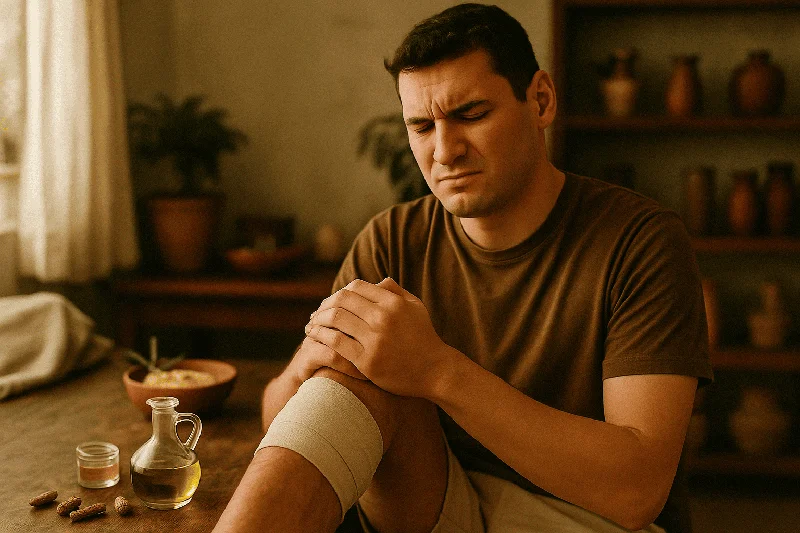Ask Ayurvedic doctor a question and get a consultation online on the problem of your concern in a free or paid mode. More than 2,000 experienced doctors work and wait for your questions on our site and help users to solve their health problems every day.
Shop Now in Our Store
Ligament Injury Treatment in Ayurveda: A Holistic Approach to Healing

Ligament injuries can be both painful and debilitating, significantly impacting mobility and quality of life. While modern medicine offers various solutions, Ayurveda presents a natural and effective approach to ligament injury treatment. Rooted in ancient wisdom, Ayurvedic remedies aim to alleviate pain, promote healing, and restore strength to the affected ligaments. This article delves into the principles and practices of ligament injury treatment in Ayurveda, providing insights into its effectiveness and practical application.
Understanding Ligament Injuries
Ligaments are fibrous tissues that connect bones and provide stability to joints. Injuries often occur due to overuse, trauma, or sudden movements, leading to sprains, tears, or strains. Common symptoms include swelling, pain, reduced range of motion, and instability in the affected area. Conventional treatments involve rest, physical therapy, and sometimes surgery. Ayurveda, however, offers a comprehensive approach that addresses the root cause and promotes holistic recovery.
Ayurvedic Remedies for Ligament Injury Treatment
Ayurvedic treatments for ligament injuries focus on reducing inflammation, alleviating pain, and accelerating tissue repair. Here are some of the most effective Ayurvedic remedies:
1. Herbal Applications
-
Ashwagandha (Withania somnifera): Known for its anti-inflammatory and strengthening properties, Ashwagandha aids in tissue repair and reduces swelling.
-
Shallaki (Boswellia serrata): This herb is highly effective in reducing inflammation and pain associated with ligament injuries.
-
Turmeric (Curcuma longa): Rich in curcumin, turmeric has powerful anti-inflammatory and antioxidant properties that promote healing.
2. Ayurvedic Oils for Massage
-
Mahanarayan Oil: This traditional oil is used for massaging injured areas to reduce pain and improve blood circulation.
-
Dhanwantharam Oil: Ideal for rejuvenating ligaments, this oil helps in restoring flexibility and strength.
Panchakarma Therapies
Ayurveda’s detoxification and rejuvenation therapies, collectively known as Panchakarma, play a crucial role in ligament injury treatment. Key therapies include:
-
Abhyanga (Oil Massage): A gentle massage using medicated oils to enhance blood flow and reduce stiffness.
-
Pizhichil: A warm oil therapy that alleviates pain and promotes muscle relaxation.
-
Kizhi: Herbal poultices dipped in warm oils are used to provide relief from inflammation and stiffness.
Ayurvedic Diet for Ligament Recovery
Diet plays a pivotal role in the Ayurvedic approach to healing. A balanced and nourishing diet supports tissue repair and reduces inflammation:
-
Include anti-inflammatory foods like ginger, turmeric, and leafy greens.
-
Consume protein-rich foods such as lentils, nuts, and seeds to aid in tissue repair.
-
Stay hydrated and consume herbal teas like ashwagandha or tulsi tea for added benefits.
Yoga and Exercises
Once the acute phase of the injury has passed, gentle yoga and strengthening exercises can help restore mobility and prevent further injuries:
-
Vrikshasana (Tree Pose): Improves balance and strengthens the supporting muscles.
-
Tadasana (Mountain Pose): Enhances posture and stability.
-
Stretching Exercises: Gradual stretches can improve flexibility and reduce stiffness.
Benefits of Ayurvedic Ligament Injury Treatment
-
Natural Healing: Ayurvedic remedies work in harmony with the body’s natural processes to promote recovery.
-
Minimal Side Effects: Unlike synthetic medications, Ayurvedic treatments use natural ingredients that are gentle on the body.
-
Holistic Approach: Ayurveda addresses both the physical and mental aspects of healing, ensuring long-term well-being.
Precautions and Considerations
While Ayurvedic treatments are effective, it is essential to:
-
Consult a qualified Ayurvedic practitioner to determine the most suitable treatment plan.
-
Avoid self-medicating or overusing herbal remedies without professional guidance.
-
Combine Ayurvedic treatments with adequate rest and physical therapy for optimal results.
Conclusion
Ligament injury treatment in Ayurveda offers a holistic and natural pathway to recovery. By incorporating herbal remedies, therapeutic oils, Panchakarma therapies, and a nourishing diet, Ayurveda not only addresses the symptoms but also strengthens the body to prevent future injuries. If you’re seeking a sustainable and side-effect-free alternative to conventional treatments, Ayurvedic solutions may hold the key to your recovery.
Explore the time-tested wisdom of Ayurveda and embrace a healthier, more resilient body. Consult an experienced Ayurvedic practitioner today to begin your journey toward holistic healing.
This article is checked by the current qualified Dr Sujal Patil and can be considered a reliable source of information for users of the site.

